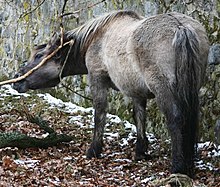
Back استئناس الخيول Arabic Domesticació del cavall Catalan ماڵیکردنی ئەسپ CKB Domesticación del caballo Spanish اهلی کردن اسب Persian Domestication du cheval French A ló háziasítása Hungarian Domestikasi kuda ID 馬の家畜化 Japanese Pembelajinakan kuda Malay

How and when horses became domesticated has been disputed. Although horses appeared in Paleolithic cave art as early as 30,000 BC, these were wild horses and were probably hunted for meat. The clearest evidence of early use of the horse as a means of transport is from chariot burials dated c. 2000 BC.[1][2] However, an increasing amount of evidence began to support the hypothesis that horses were domesticated in the Eurasian Steppes in approximately 3500 BC.[3][4] Discoveries in the context of the Botai culture had suggested that Botai settlements in the Akmola Province of Kazakhstan are the location of the earliest domestication of the horse.[5] Warmouth et al. (2012) pointed to horses having been domesticated around 3000 BC in what is now Ukraine and Western Kazakhstan.[6]
Genetic evidence indicates that domestication of the modern horse's ancestors likely occurred in an area known as the Volga–Don, in the Pontic–Caspian steppe region of eastern Europe, around 2200 BC. From there, use of horses spread across Eurasia for transportation, agricultural work, and warfare. Scientists have linked the successful spread of domesticated horses to observed genetic changes. They speculate that stronger backs (GSDMC gene) and increased docility (ZFPM1 gene) may have made horses more suitable for riding.[3][4]
- ^ Cite error: The named reference
Anthony2007was invoked but never defined (see the help page). - ^ Cite error: The named reference
Kuznetsov2006was invoked but never defined (see the help page). - ^ a b Cite error: The named reference
Dancewas invoked but never defined (see the help page). - ^ a b Cite error: The named reference
Libradowas invoked but never defined (see the help page). - ^ Outram, Alan K.; et al. (2009). "The Earliest Horse Harnessing and Milking". Science. 323 (5919): 1332–1335. Bibcode:2009Sci...323.1332O. doi:10.1126/science.1168594. PMID 19265018. S2CID 5126719.
- ^ Whence the Domestic Horse? | Science | AAAS
© MMXXIII Rich X Search. We shall prevail. All rights reserved. Rich X Search